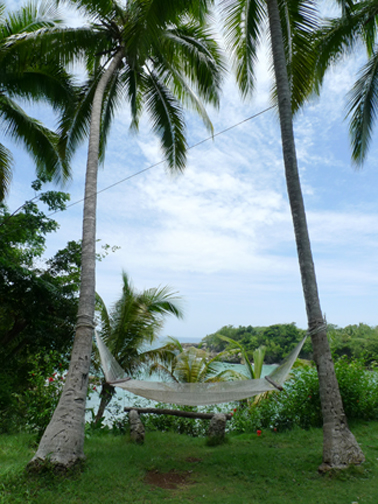I’ve spent two years in Haiti after the earthquake doing relief and early recovery work. These years have had their success and challenges in the chaotic emergency, but for the most part much good was done for the people of Haiti in the end. This photo journal gives a peripheral glance at some of the projects and shares a beautiful side of the small island that often goes unnoticed in the midst of chronic poverty and natural disasters.
When speaking of the Caribbean Westerners conjure up images of hammocks on white sandy beaches, cocktails and moonlit nights in Jamaica or the Bahamas. Haiti, ironically, is in the middle of all the popular tropical tourist locations. But before the earthquake many Americans would not know which hemisphere it falls in, or how far off it is from the States (actually only 2.5 hour flight from Miami).
Seven months after the historic earthquake I joined Samaritan’s Purse Haiti and spent 12 months living in a 20’x32’ military tent that was divided into quadrants furnished with plywood furniture that is constructed by the earthquake response shelter team (when they weren’t building temporary shelters). The 60-acre base is ocean-front and in the back are hills, where most Americans would pay millions to build their home.
We lived in community, sharing everything on the base and effectively became very close. Coordinating programs in that context was made easy by having such close access to the team members. The beach resorts were near and were popular venues for entertainment and R&R get-aways. My position took me in the other direction into the city twice a week, and I was really one of the few who were in touch with other agencies on a regular basis. My main form of entertainment was entertaining the volunteers with Scrabble and Blitz, and for exercise I took power walks around the base every night, activities I actually continued through my year with World Vision when I moved to Black Mountain.
Our peaceful co-existence ended in October when cholera hit the country (only 10 months after the earthquake). The work day went from 8-hour to 14-16 hours. The Medical/WASH Teams helicoptered to the cholera source site in Artibonite everyday. The Shelter Team went from building base furniture to building two cholera clinics that had a 350 capacity total, all within 6 weeks. I went from attending choice UN cluster meetings to rushing to emergency cholera sessions to get resources for our work, and raising funds to get the quick cash for our operations in Cabaret and Cite Soleil. Every department had its work cut out and everyone was putting in maximum hours, sleeping very little. This frenetic pace lasted until March when the patient in-take numbers finally began to ease. By then most of the earthquake relief staff was out of steam and was ready to head home. By the end of my term in July I also left, but came back to Haiti almost immediately with World Vision. World Vision at that time was beginning to end its emergency response phase, and I found myself at the crossroad of relief and early rehabilitation, which I truly believe God had a hand in orchestrating because it was a good fit for my personality and skills. Understanding my role made the challenging moments more bearable for both of those years.
Samaritan’s Purse T-Shelter Project
Beneficiaries’ gardens
Neighbors hanging out
Man posing in front of his shelter
Young lady and child
Young boys at internally displaced people site
Kite flying for recreation at the shelter project site
In less than 9 months after the earthquake, the Samaritan’s Purse Shelter Team provided an impressive 15,000 t-shelters to displaced families. This is the highest number compared with all other agencies who implemented shelter programming in the country. It is one of the signature projects that put SP on the map in Haiti.
IDP (Internally Displaced People) Camps
Camp Management/Transition was a major project taken on by World Vision right after the quake, and was one of its most successful projects. The agency managed 16 camps in Petionville and Port au Prince while providing comprehensive services to approximately 10,000 displaced individuals.
Top view of one of World Vision’s IDP camp sites in Petion-Ville
Man washing by water tank
Children playing soccer by the latrines and recycling area
Samaritan’s Purse Cholera Response
The cholera outbreak began in October in the Central Plateau, and within 2 weeks was spreading quickly towards Port au Prince, the country’s crowded capital that had been laid waste from the earthquake only 9 months prior. Samaritan’s Purse headquarters sits along the route between Port au Prince and the Plateau, where few to no other international NGOs was present due to its distance from Port au Prince and the earthquake area. Taking advantage of its strategic location SP began building a clinic in Cabaret/Bercy. This clinic was erected almost overnight as the staff worked night and day in anticipation of impending peaks that took place soon after the clinic’s completion. This move eventually saved thousands of lives in a desolate area that had few water sources for its relatively large population.
The Cite Soleil clinic was erected with much more planning, taking into consideration the area’s high security risk. Careful negotiations took place with the local government and local gangs, and collaboration with private donors to make this second project happen. Patients came in by the hundreds each week, including those from other agencies’ overflow. This clinic stood as a stalwart structure in where the UN calls the most dangerous city neighborhood in the Western Hemisphere, giving hope in time of cholera, and provided jobs for local residents, which included former gang members. One institutional donor labeled the clinic as the ‘Cadillac’ of all the clinics during this outbreak.
SP also implemented outreaches in remote mountain areas via helicopter. Besides saving lives, through this ministry many young men and women in the gang infested area of Cite Soleil also came to experience God’s love and was rescued from a life of gang. Samaritan’s Purse continued its operations in Cite Soleil building on these relationships even after the closure of the clinic.
Cite Soleil Cholera Clinic
The initial stage of construction began with renovating the wall
Local workers placing barbed wire as part of security measures in Cite Soleil
Barbed wires that separate the clinic to the outside
Rubble in front of clinic wall prior construction
Volunteer construction worker clearning rubbles and flattening land
Silhouetted workers at twilight time
Doctors and nurses checking on patients inside clinic
Young patient resting in children’s section
UN soldiers keeping the peace inside clinic
National workers checking out of shift
Bercy Cholera Clinic
One of the 12 treatment tents at Bercy clinic
Inside one of the tents
Volunteer doctors and nurses tending to patients
Male patients in treatment
Mother reading Scriptures while tending to baby
One of few who did not make it
BGEA Chaplain praying for patient
Father gazing at child suffering from cholera
Nurse’s aid assisting patient at handwashing station.
The Apparent’s Livelihood Project
Apparent (a parent) is one of the most successful micro-enterprise projects in Port au Prince. It is a faith-based project whose mission is to keep families together by improving their economic situation. The agency carries out the biblical mandate to care and provide for “the fatherless, the widow, and the alien.” This project has provided training and jobs for thousands of displaced individuals and families. The innovative idea behind the products is to use recycled cereal boxes and turn them into jewelry.
The store is located on an alley like dirt road, well tucked behind a set of metal gates. Without signage pointing from the main street through the long windy dirty road it would be almost impossible to locate. Behind the gates and down the narrow steps lie a quaint boutique that fronts an organized operations with workers trained for each production step. The store displays artisan products that look like they belong in a mall.
The photos below document the production line from cereal boxes to necklaces and bracelets.
Signature line necklaces on wall display
Cereal boxes being cut as first step to making jewelry beads
Women workers glueing cut cereal boxes to make beads
Glued pieces ready for shaping
Beads being sundried before stringing
Pre-beads on sticks
Final products in store
Upstairs: Workers from partner agency Papillon Enterprise working on jewelry.
Downstairs: Outdoor displays
On each string of necklace is a piece of information on one of the workers, describing their situation and the positive impact the project has on their family.
Port au Prince Area
Downtown Port au Prince
Decorated tap tap on Rte Nationale 1 along the coast
Black Mountain area
Women carrying vegetables to the market in the morning
Street vendors along Route Delmas, between Port au Prince and Petion-Ville
Circle intersection at Port au Prince airport
Open air 18-wheeler at junction between Rte 1 and 9
IDP camp site in Cite Soleil
Boys walking through a flooded soccer field in Cite Soleil
Man walking on ledge along one of the most insecure streets of Cite Soleil before the UN’s arrival in 2004
Faces of Jacmel
Shoe repairman
Siesta on the sand
Young man behind fence
Haiti in colors
Boatman at Wahoo Beach

Ile a Vache

Girls on the sand (Jacmel)

Young girl peeking behind water container (Ile a Vache)

Man on donkey (Ile a Vache)
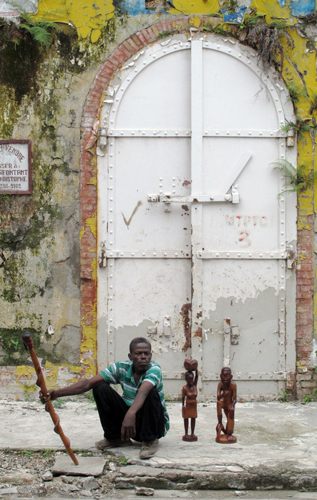
Sidewalk vendor (Jacmel)

Woman and donkey (Ile a Vache)
La Isla Bonita
These photographs were taken in Jacmel, Ile a Vache, and Indigo Beach Resort, representing some of Haiti’s most well known resorts. It is a Haiti that is only enjoyed by a few privileged and mostly expats. But it shows that it is a Haiti that can exist elsewhere, if it can here – a possibility that Haitians themselves can realize.

Entrance to Indigo Beach
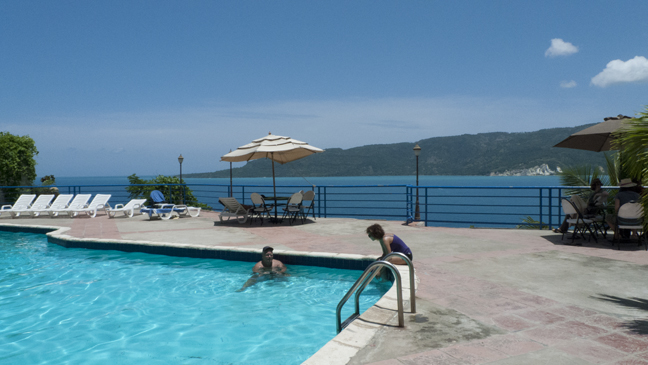
Hotel Cap Lamandou
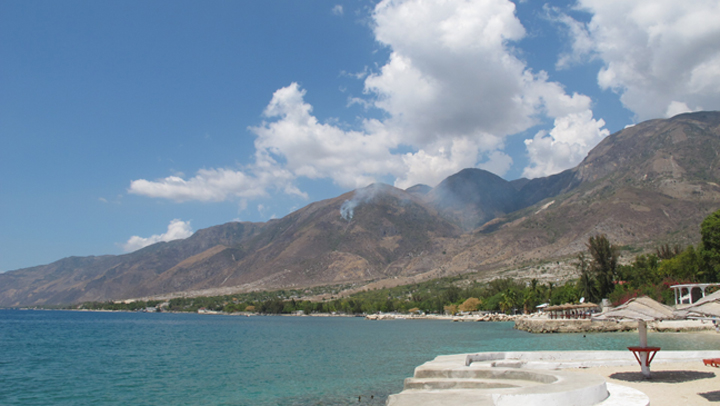
Wahoo Beach

Abaka Bay dock
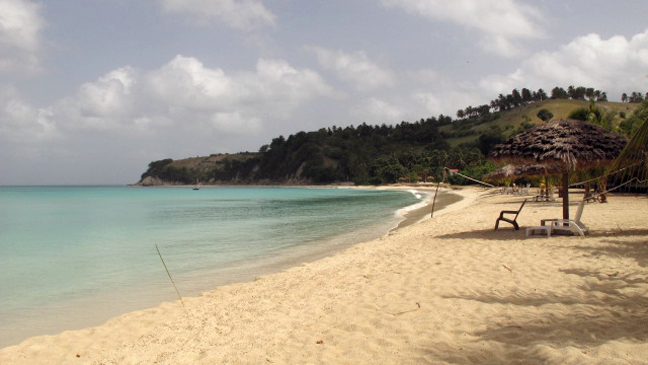
Ile a Vache shore

Jacmel from Cyvadier Hotel
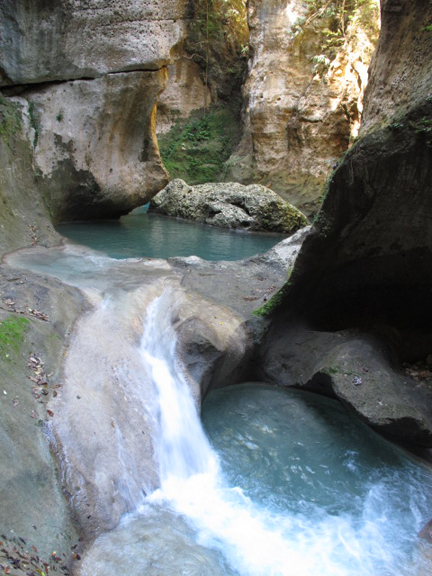
Bassin Bleu, Jacmel
